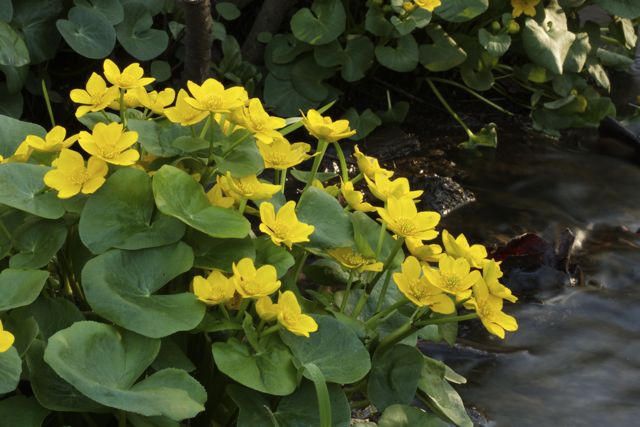Common names for plants and plant species can be confusing. A single plant could have several common names. And a single common name might refer to a whole slew of different species.
Marsh Marigold (Caltha spp.) is one such genus where confusion may occur. In the Pacific Northwest there are two common species of Marsh Marigold; White Marsh-Marigold (Caltha leptosepala) and Yellow Marsh-Marigold (Caltha Palustris.). Both grow along the west coast of North America and share similar growth patterns and ecology.

Identifying Marsh Marigold
A perennial herb growing with a mostly naked, hollow stem from a basal rosette of leaves. The leaves are 13 to 15 centimeters long when fully grown and have smooth, wrinkled, or toothed edges. Young leaves are protected by a membranous sheath up to 3 cm long. Marsh marigold flowers do not have petals, but rather petal-like sepals and long flat stamens in the center. These sepals may be thin or rounded like an inverted egg sort of shape.
White and Yellow Marsh Marigold share these identifying traits. The main visual difference between the two varieties is their flowers.

White Marsh Marigold produces white flowers. Each stem grows between 3-10 cm tall and produces one or more flowers. Each flower is 1 to 4 centimeters long.

Yellow Marsh Marigold produces Yellow Flowers. The flowers of Yellow Marsh Marigold are bigger, between 2-5cm in diameter. Each stem grows between 10-80 cm tall and produces between four and six flowers.
Where and When to Forage
As the name suggests, Marsh Marigold favors wet environments. You can find both varieties in marshes, bogs, fens, and wet woodlands in temperate regions. Marsh Marigold prefers partial shade. It likes richer soils and is shy of brackish water. It is native to western North America, from Alaska and down to New Mexico.

Marsh Marigold flowers between April and August and dies down in Autumn. It overwinters with buds near the surface of the soil. Around the edges of lakes and rivers it grows between reeds. The best time to locate this plant is during its blooming period, when bright yellow or white flowers dominate the scene and make them easy to spot.
Edibility
No matter which variety of Marsh Marigold you are foraging, it absolutely must be cooked before eating, no exceptions. Marsh Marigold varieties contain high quantities of a toxin called protoanemonin, and this toxin is present in all parts of the plant.

Early spring greens of Marsh Marigold varieties are edible only after cooking. The recommended preparation for the greens is boiling until barely tender, cutting into bite sized pieces, lightly salted, and served with melted butter and vinegar.
Some sources note that the leaves can be used as a potherb, but again only after several short boiling’s with changes of water between. Another source claims that the root may be cut, boiled, and eaten.
Most experts advise against eating any parts of the Marsh Marigold.
Cautions and Considerations
Marsh Marigold, when uncooked, is extremely poisonous. Eating this plant raw and in large quantities can result in convulsions, burning of the throat, bloody diarrhea, dizziness, and fainting.
Skin or mucous membrane contact with the juices of the Marsh marigold may cause blistering or inflammation. Younger plants have fewer of these toxins and heat breaks the substances down.

Sources have attributed Marsh Marigold to gastrointestinal distress and loss of livestock, so greens and flowers should not be given to pets either.
Overall, while Marsh Marigold is edible, this writer recommends only consuming in small quantities and only if you are certain that you have prepared it properly. Always avoid uncooked young leaves and flowers. Otherwise, without that certainty, avoid consuming this particular plant.
—————Written by Taylor Calderon
Taylor Calderon is a freelance graphic designer and writer from South Texas. They have a passion for art, food, and living self-sufficiently. They enjoy writing on a variety of topics and issues, from sustainable living to botanicals and foraging, to travel and culture. To see more of their work, you can view their portfolio at www.flamingink.art
Many of our readers find that subscribing to Eat The Planet is the best way to make sure they don't miss any of our valuable information about wild edibles.
See our privacy policy for more information about ads on this site






